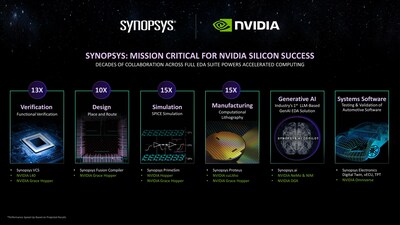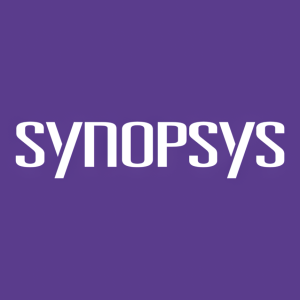Synopsys Showcases EDA Performance and Next-Gen Capabilities with NVIDIA Accelerated Computing, Generative AI and Omniverse
- Collaboration between Synopsys and NVIDIA to accelerate chip design and automotive prototyping.
- Projected up to 15x runtime gains across design, verification, simulation, and manufacturing processes.
- Integration of generative AI capabilities for chip design with NVIDIA technologies.
- Collaboration to advance digital twins for automotive design with NVIDIA Omniverse platform.
- None.
Insights
The collaboration between Synopsys and NVIDIA to enhance chip design and automotive prototyping with AI and accelerated computing indicates a strategic move that could have significant implications for the semiconductor and automotive industries. The integration of Synopsys' EDA tools with NVIDIA's GH200 Grace Hopper Superchip and the use of generative AI for chip design suggests a substantial improvement in efficiency and performance. The projected runtime gains of up to 15X could lead to faster time-to-market for new chip designs, potentially giving both companies a competitive edge. This collaboration could also influence the stock performance of both Synopsys and NVIDIA, as investors may view the partnership as a growth catalyst. The emphasis on AI and accelerated computing in chip design aligns with current technological trends, which could attract further investment into these sectors.
The announcement highlights the potential transformation in automotive design through the integration of Synopsys' virtual prototyping solutions with NVIDIA's Omniverse platform. This collaboration is set to enable the creation of advanced digital twins, which could revolutionize the testing and validation process for software-defined and autonomous vehicles. The ability to simulate both vehicle electronics and environmental factors in a digital space offers a glimpse into a future where automotive safety and functionality can be enhanced significantly before physical production. This could lead to cost reductions and faster development cycles for automotive companies, potentially impacting their profitability and market share. As a result, stakeholders in the automotive sector, including manufacturers and technology providers, should monitor these developments closely.
The partnership's focus on computational lithography, particularly the production collaboration between Synopsys, NVIDIA and TSMC using NVIDIA cuLitho, is indicative of the industry's push towards the limits of semiconductor manufacturing technology. This effort to accelerate manufacturing and address the challenges of advanced chip production underscores the importance of innovation in maintaining Moore's Law. This could have implications for the broader semiconductor industry, impacting supply chains and the balance of power among chip manufacturers. As advanced semiconductor chips become more important for a wide range of applications, from consumer electronics to high-performance computing, the ability to innovate in manufacturing processes could become a key differentiator, potentially affecting market dynamics and company valuations.
Expanding Decades of Collaboration Across Synopsys' Full EDA Stack
News Highlights:
- Enabling Synopsys' industry-leading full AI-driven EDA stack on the NVIDIA GH200 Grace Hopper Superchip; projecting up to 15x run-time gains across design, verification, simulation and manufacturing
- Integrating Synopsys.ai generative AI capabilities for chip design with the NVIDIA AI Enterprise software platform — including NVIDIA microservices — and NVIDIA accelerated computing infrastructure
- Extending Synopsys automotive virtual prototyping solutions with NVIDIA Omniverse to deliver next-generation digital twins
"Synopsys has a proud history of empowering engineering teams to solve previously unsolvable challenges, and now we're taking that to the next level by harnessing the power of AI and accelerated computing," said Sassine Ghazi, president and CEO of Synopsys. "Today, we're presenting the performance potential across Synopsys' leading full EDA stack supercharged by the NVIDIA GH200 Grace Hopper™ Superchip, along with new initiatives with NVIDIA to help maximize the capabilities of engineering teams working on technologies from silicon to automotive systems."
Accelerating Synopsys' Industry-Leading AI-Driven EDA Suite on NVIDIA GPUs
Synopsys is applying NVIDIA accelerated compute architectures, including the NVIDIA GH200 Grace Hopper Superchip, to achieve significant, projected runtime gains of up to 15X compared to current methods, across the full EDA stack spanning design, verification, simulation and manufacturing. Specifically:
- Synopsys VCS®: Industry's highest-performance simulation and constraint solver engines accelerate functional verification workloads on NVIDIA GPUs. Using advanced Fine-Grained Parallelism (FGP) technology and massively parallelized graph evaluation enables users to find bugs earlier, faster and smarter.
- Synopsys Fusion Compiler™: Enables accelerated hybrid CPU/GPU performance scaling across digital placement, providing massive parallelization for compute-intensive exploration and optimization.
- Synopsys PrimeSim™: Accelerates SPICE simulation workloads by leveraging the power of NVIDIA GPUs. The heterogeneous, accelerated compute architecture enables the simulation of challenging circuits to achieve signoff with SPICE-level accuracy, reducing runtimes from days to hours.
- Synopsys Proteus™: Provides optical proximity correction software (OPC) for the acceleration of computational lithography, the largest workload in the semiconductor manufacturing process. Synopsys OPC software running on the NVIDIA cuLitho software library dramatically accelerates computational lithography workloads compared to current CPU-based methods.
"Our collaboration with Synopsys on generative AI and digital twins is central to the future design, automation and manufacturing of chips," said Jensen Huang, founder and CEO of NVIDIA. "Synopsys' EDA suite, together with NVIDIA's accelerated computing architecture, demonstrates the gains that can be achieved for these exceptionally demanding industrial workloads."
In addition, Synopsys and TSMC are going to production with NVIDIA cuLitho, a computational lithography platform, to accelerate manufacturing and push the limits of physics for the next generation of advanced semiconductor chips.
Collaborating to Advance Generative AI for Chip Design
Synopsys is extending its Synopsys.ai LLM-based capabilities, beginning with Synopsys.ai Copilot, to support NVIDIA AI and compute platforms, giving customers more flexibility to customize their data sets and enable air-gapped on-prem deployment. Synopsys.ai Copilot is an industry-first generative AI capability that is designed to help engineering teams accelerate time to market and address systemic complexity through the power of conversational intelligence.
Synopsys will utilize the NVIDIA AI Enterprise software platform, which includes NVIDIA NeMo™ framework, and NVIDIA NIM inference and NeMo Retriever microservices deployment containers. Synopsys customers will be able to deploy Synopsys.ai Copilot on air-gapped on-prem environments, leveraging the accelerated computing performance of NVIDIA DGX systems.
The Synopys.ai Copilot capability is currently available for early-access trials.
Transforming Automotive Design with Electronics and Environmental Digital Twins
The automotive industry is being transformed by digitalization and accelerated computing. Automotive design teams are now building and validating their products in the digital world before manufacturing them in the real world. Synopsys is collaborating with NVIDIA to integrate Synopsys' leading electronics digital twin solutions with the NVIDIA Omniverse™ platform to reduce costs and time to market and improve the safety of software-defined and increasingly autonomous vehicles.
Synopsys systems software, virtual ECU and electronics digital twin fabric will be connected with Omniverse, a development platform for building interoperable 3D applications for industrial workloads. Synopsys' virtual prototyping solutions provide automotive engineering teams with a digital twin of the electronic system of the car to enable the development, testing and validation of the car's software and electronic systems. Omniverse delivers physically based visualization and simulation of environmental factors.
Together, these capabilities can provide engineering teams with a digital twin of both the vehicle electronics and the environment, allowing them to test and validate embedded software, safety and autonomy features well ahead of production. Synopsys expects to begin engaging with lead customers on the solution in the second half of 2024, with general availability expected in 2025.
About Synopsys
Catalyzing the era of pervasive intelligence, Synopsys, Inc. (Nasdaq: SNPS) delivers trusted and comprehensive silicon to systems design solutions, from electronic design automation to silicon IP and system verification and validation. We partner closely with semiconductor and systems customers across a wide range of industries to maximize their R&D capability and productivity, powering innovation today that ignites the ingenuity of tomorrow. Learn more at www.synopsys.com.
Forward-Looking Statements
This press release contains forward-looking statements, including, but not limited to, statements regarding strategies related to products, technology and services and planned product releases and capabilities. These statements involve risks, uncertainties and other factors that could cause our actual results, time frames or achievements to differ materially from those expressed or implied in such forward-looking statements. Such risks, uncertainties and factors that could affect Synopsys' results is included in filings we make with the SEC from time to time, including in the sections entitled "Risk Factors" in our latest Annual Report on Form 10-K and in our latest Quarterly Report on Form 10-Q. The information provided herein is as of March 20, 2024. Synopsys undertakes no duty to, and does not intend to, update any forward-looking statement, whether as a result of new information, future events or otherwise, unless required by law.
EDITORIAL CONTACT
Kelli Wheeler
Synopsys, Inc.
650-584-5000
corp-pr@synopsys.com
![]() View original content to download multimedia:https://www.prnewswire.com/news-releases/synopsys-showcases-eda-performance-and-next-gen-capabilities-with-nvidia-accelerated-computing-generative-ai-and-omniverse-302091775.html
View original content to download multimedia:https://www.prnewswire.com/news-releases/synopsys-showcases-eda-performance-and-next-gen-capabilities-with-nvidia-accelerated-computing-generative-ai-and-omniverse-302091775.html
SOURCE Synopsys, Inc.









